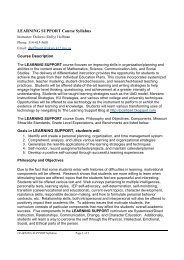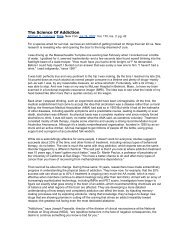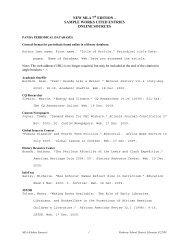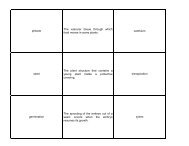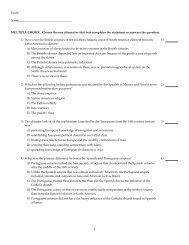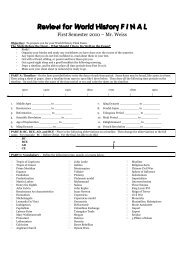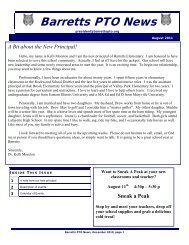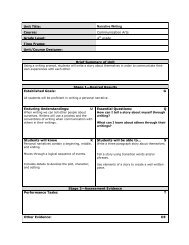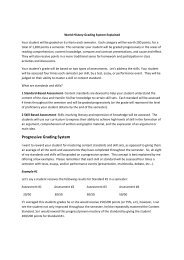Environments Powerpoint
Environments Powerpoint
Environments Powerpoint
Create successful ePaper yourself
Turn your PDF publications into a flip-book with our unique Google optimized e-Paper software.
<strong>Environments</strong><br />
Terrestrial and Aquatic
Vocabulary<br />
Terrarium:<br />
a mini garden in an<br />
enclosed container<br />
Organism:<br />
any living thing, including<br />
plants and animals<br />
Environment:<br />
everything that<br />
surrounds and<br />
influences an<br />
organism<br />
Environmental Factors: one part of the<br />
environment. Can be<br />
living and non-living: water,<br />
light, temperature, chemicals or<br />
a plant or an animal
Environmental Factors
Terrestrial <strong>Environments</strong><br />
Understandings<br />
How do you determine what is an<br />
environments?<br />
– An environment is everything that<br />
surrounds an influences an organism.<br />
How do we distinguish one thing<br />
from another?<br />
– Each part of an environment, living or<br />
non living, is recognized as an<br />
environmental factor.
Terrarium Observations<br />
How do the sides and the top of the<br />
terrarium look?<br />
How does the soil look?<br />
Have any seeds sprouted?<br />
What kin sprouted first? What kind<br />
sprouted last? (or yet to sprout?)<br />
What type of plant grows best in the<br />
terrarium?<br />
Which group’s s terrarium is doing best?
Terrarium Observations<br />
How have the living factors of the<br />
environment changed?<br />
How have the non living factors<br />
changed?<br />
How would you recommend planting<br />
seeds in a terrarium?
Germinate<br />
– When a seed germinates, it sprouts, or<br />
starts to grow and develop
How does the environment in the<br />
terrarium change over time?<br />
– Some plants grow but not all<br />
– Moisture forms on the sides of the<br />
container<br />
– Plants need water and light to grow
Investigation Two<br />
Bugs and Beetles, Oh My!
Investigation Two<br />
Part One<br />
Organize into teams<br />
Introduce isopods and beetles<br />
– They are living animals and nothing<br />
should be treated with respect<br />
We will have:<br />
– isopods<br />
– darkling beetles (tenebrio(<br />
– adult<br />
mealworms)
Environmental Preference<br />
Isopods<br />
–Moist area<br />
–Decayed<br />
vegetation<br />
–Wood and bark<br />
(mulch)<br />
–rock<br />
Darkling Beetles<br />
–Dark dry place<br />
–Log<br />
–Leaves<br />
–Cereal
Animals and Environmental Factors<br />
and Preference<br />
We can keep these animals in our<br />
terrariums if the environment is<br />
suitable. Let’s s find out what kind of<br />
environment our animals prefer.<br />
Can you think of a way to use your<br />
runways to find out how much water<br />
isopods and beetles like in their<br />
environment?
Bugs and Beetles<br />
Part 2<br />
Responding to Moisture
Part 2<br />
Responding to Moisture<br />
You will need:<br />
– Student Sheet No. 6<br />
– Response Sheet – Bugs and Beetles
Part 2<br />
Responding to Moisture<br />
Let’s s design an experiment to determine<br />
moisture preference<br />
Use three equal piles of soil separated<br />
from one another by a bit of open space<br />
One measure of the soil should be dry,<br />
another moist, and a third wet<br />
The isopods and beetles need plenty of<br />
time to explore the environment in order<br />
to show preference
Part 2<br />
Responding to Moisture<br />
Use three equal piles of soil<br />
separated from one another by a bit<br />
of open space<br />
One measure of the soil should be<br />
dry, another moist, and a third wet<br />
The isopods and beetles need plenty<br />
of time to explore the environment in<br />
order to show preference
Part 2<br />
Responding to Moisture<br />
Soil samples will all be 50 mL<br />
Wet soil is made by adding two 5 mL<br />
spoons of water to 50 mL of moist<br />
soil and mixing thoroughly<br />
The samples of soil with different<br />
moistures should be touch each<br />
other in the runway<br />
One team will investigate isopods,<br />
the other beetles.
Vocabulary<br />
Variable: something that can be<br />
changed<br />
Environmental factor: one part of the<br />
environment. It can be nonliving or<br />
living<br />
Isopod<br />
Beetle
Inquiry Questions<br />
How can we determine what type of<br />
environment isopods and beetles<br />
prefer?<br />
Design an investigation by<br />
controlling the environmental factors<br />
(variables) so that one factor can be<br />
observed at a time.
Preferred environment: : the set of<br />
environmental conditions that an<br />
organism appears to choose over<br />
other conditions<br />
How much moisture to isopods and<br />
beetles prefer?<br />
– Isopods usually prefer moist<br />
environments<br />
– Beetles usually prefer dry environments
What evidence have you gathered<br />
that indicates your animals’<br />
environmental preference for light?<br />
Describe the preferred environment<br />
of isopods and beetles from the<br />
evidence we have so far.<br />
Why do you think isopods prefer<br />
more moist environments than<br />
beetles?
Isopods and beetles usually prefer<br />
dark environments
Investigation 3<br />
Water Tolerance
What is it?<br />
Water Tolerance<br />
Organisms have ranges of tolerance for<br />
environmental factors.<br />
Organisms have specific requirements for<br />
successful growth, development, and<br />
reproduction<br />
Optimum conditions are those most<br />
favorable to an organism’s s survival,<br />
growth, and reproduction
Vocabulary<br />
Water Tolerance<br />
– Preferred environment<br />
– Environmental factors<br />
– Optimum conditions<br />
– Tolerance<br />
– Range of tolerence<br />
– Controlled experiment
Water Tolerance<br />
How would you design an experiment<br />
to investigate water tolerance?<br />
Your experiment must have to<br />
following:<br />
– Materials<br />
– Specific procedures<br />
– Independent variable<br />
– Dependent variable<br />
– How will you collect data?<br />
– How would you graph the data?
Aquatic <strong>Environments</strong><br />
Investigation 4
Part 1: Goldfish Aquariums<br />
Getting Ready<br />
– Age tap water<br />
What?<br />
– When are the goldfish coming?<br />
– Elodea<br />
– The future of our goldfish<br />
– Read Science Stories: Aquatic<br />
<strong>Environments</strong> Around the World
Part 1: Goldfish Aquariums<br />
Discuss Aquatic <strong>Environments</strong><br />
Introduce the Aquariums<br />
Familiarize yourself with this section<br />
in your journal
Goldfish Environment<br />
Aged or conditioned tap water<br />
Light and heat<br />
Aquarium wall<br />
Gases and other materials in the<br />
water<br />
Other goldfish<br />
What’s s missing?
Goldfish <strong>Environments</strong><br />
We need to treat our tap water to<br />
make it a suitable environmental<br />
factor for our new friends<br />
We will use a water conditioner
Acid in the Water
Acid in Water<br />
Bromothymol blue<br />
– What is it?<br />
– Tests for acidity in water<br />
– If the water turns blue: none<br />
– If water turns green: little acidity<br />
– If the water turns yellow: significant<br />
amount of acid present
Acid in Water<br />
What might cause the different in the<br />
amounts of acid in the water<br />
samples?
Acid in Water<br />
Could we design an experiment to<br />
test the source of the acid?<br />
I will give you a hint on the<br />
materials:<br />
– Investigations with BTB sheet in journal<br />
– 3 cups<br />
– 3 lids<br />
– 1 beaker<br />
– 1 goldfish<br />
– 1 sprig of Elodea<br />
– BTB chemical (please be careful)
Acid in Water<br />
What happen?<br />
What can we conclude?
Acid in Water<br />
Content (this would be included in<br />
your conclusion – or is should be : )<br />
– Carbon Dioxide CO2 produced by<br />
aquatic organisms changes the acidity<br />
of the water
Acid in Water<br />
Vocabulary<br />
–Indicator:: a chemical used to test for<br />
the presence, absence, or amount of<br />
a substance in a material (ex. BTB<br />
tests for the presence of acid)<br />
–Carbon dioxide: : is a colorless,<br />
odorless gas, present in the<br />
atmosphere. It is released by<br />
animals and plants during respiration
Aquatic <strong>Environments</strong><br />
Part 3: New Organisms
Science Stories<br />
New Organisms<br />
– Water Pollution: The Lake Erie Story,<br />
Sources of Water Pollution, and What is<br />
an Ecosystem?
New Organisms<br />
What could we do to the goldfish<br />
aquarium to make it more diverse<br />
and interesting?
New Organisms<br />
Small pond snails<br />
Gammarus – a “hardy” crustacean<br />
What would adding these new<br />
organisms do for our aquarium?
New Organisms<br />
What is a natural freshwater<br />
environment like?<br />
How is an aquarium similar to a<br />
natural freshwater environment? How<br />
is it different?<br />
Which organism (plant or animal) is<br />
your favorite one in this investigation<br />
and why?<br />
If you were to set up an aquarium<br />
again, what would you do differently<br />
and why?
New Organisms<br />
What changes have we noticed in our<br />
aquarium?<br />
If our aquariums were located in the<br />
sun, what might happen?<br />
If we were able to add new<br />
organisms, what might happen?<br />
Would the goldfish eat small<br />
crustaceans?<br />
Would the small crustaceans eat<br />
anything?<br />
What do we call this?
New Organisms<br />
Let’s s make sure we are up-to<br />
to-date<br />
on our vocabulary<br />
New Content Understanding:<br />
An aquatic environment can contain<br />
many different organisms<br />
Extension Activities
Investigation 5<br />
Brine Shrimp
Brine Shrimp – Setting up the<br />
experiment<br />
What are the different types of<br />
environments we have discussed?<br />
– Terrestrial (land)<br />
– Aquatic (water)<br />
Key Ideas<br />
– Range of Tolerance<br />
– Salinity
Introduce Brine Shrimp<br />
What are they?<br />
Dr. Bryan needs to finds out if<br />
salinity is an environmental factor<br />
that affects the hatching of Mono<br />
Lake’s s brine shrimp eggs. She needs<br />
to design an experiment to find an<br />
answer to her question.
Brine Shrimp Vocab. and Content<br />
Understandings<br />
Brine Shrimp: are tiny animals<br />
related to crabs and lobsters.<br />
Brine shrimp are found in salt<br />
ponds and lakes<br />
Salinity: how salty water is, the<br />
concentration of salt in water<br />
Range of tolerance: the range of<br />
what a certain animal can handle<br />
of one environmental factor
Brine Shrimp Vocab. and Content<br />
Understandings<br />
In a controlled experiment<br />
one variable (salt) is isolated<br />
and tested. All other<br />
variables are held constant<br />
(controlled) ex. Amount of<br />
water, amount of brine<br />
shrimp eggs
Brine Shrimp Hatching<br />
0<br />
spoons<br />
Salt Conditions<br />
2<br />
spoons<br />
4<br />
spoons<br />
6<br />
spoons<br />
Most<br />
Some<br />
None
Part 3<br />
Viability
Determining Viability<br />
Did any more brine shrimp hatch?<br />
When something is alive and able to<br />
function and grow, it is said to be<br />
viable.<br />
Viable: alive or able to grow.
Determining Viability<br />
Do you think the eggs that didn’t<br />
hatch are viable or dead? How could<br />
you find out if the eggs that have not<br />
hatched in your cups are still viable<br />
(alive and able to grow)?
Determining Viability<br />
Brine shrimp eggs remain viable but<br />
don’t t hatch until the conditions are<br />
within the range of tolerance for that<br />
organism




